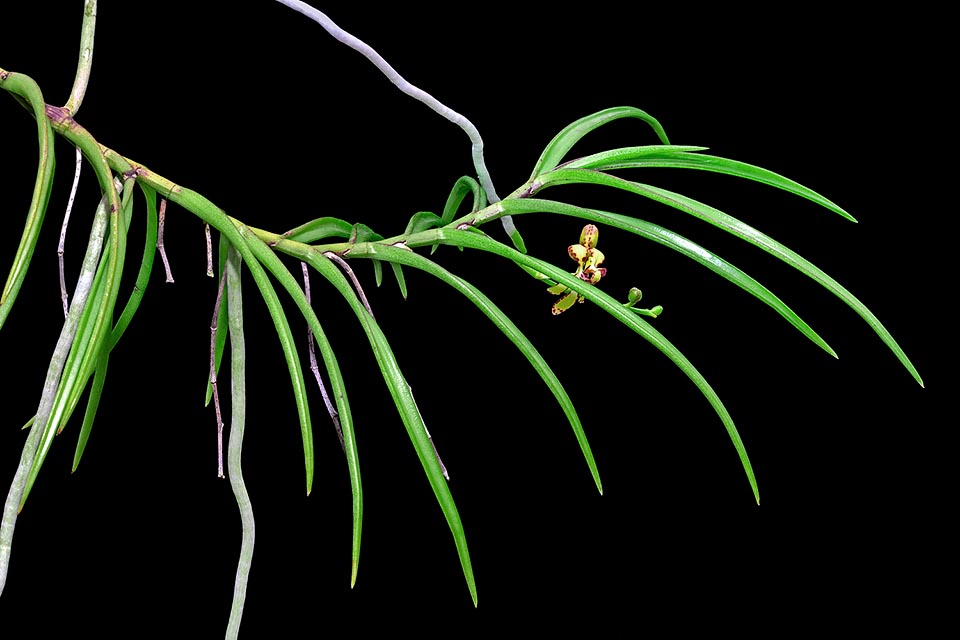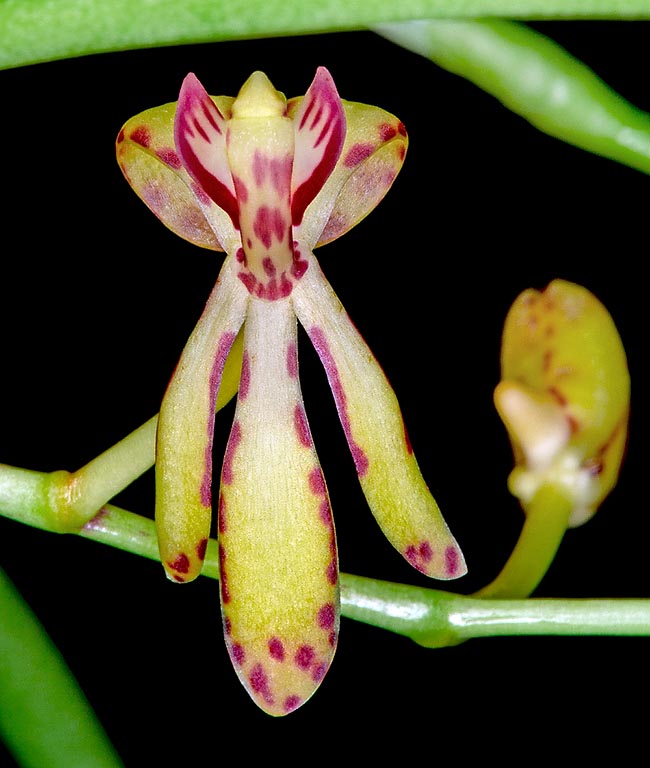Family : Orchidaceae

Text © Pietro Puccio

English translation by Mario Beltramini
The species is native to Peninsular Malaysia and Peninsular Thailand where it grows in the humid forests on the branches of the trees or on granite outcrops covered by a thin layer of organic substance, from the sea level up to about 400 m of altitude.
The name of the genus is the combination of the Greek substantives “ῥήν” (ren) kidney and “ανθηρά” (anthera) = anther, with reference to the reniform lobes of the anthers; the specific name is the Latin adjective “histrionicus, a, um” = histrionic, in the sense of gaudy, showy, with reference to the flowers.
Common names: h̄wāy h̄elụ̄xng (Thai).

The Renanthera histrionica is an epiphyte or lithophyte species of granite rocks native to the peninsular forests of Malaysia and Thailand. Erect or semi-pendent stems, at times ramified, 40-60 cm long, from where start robust aerial roots and alternate semi-cylindrical leaves of 7-12 cm, pointed and grooved above © Giuseppe Mazza
The Renanthera histrionica Rchb.f. (1878) is an epiphyte or lithophyte monopodial species with erect or semi-pendent stems, at times ramified, 40-60 cm long, from where depart robust aerial roots.
Alternate, distichous, semicylindrical leaves, with acute or acuminate apex, grooved above, 7-12 cm long and 0,5-0,7 cm broad, fleshy, of dark green colour.
Axillary racemose inflorescences almost horizontal, 5-14 cm long, bearing up to 10 flowers, on a 0,9-1,4 cm long pedicel and ovary, not resupinate (with the labellum up over the column), of about 2,5 cm of diameter, fleshy, with pale yellow sepals and petals with violaceous red margins and dots, opening in succession 2-3 at the time.

Small but showy fleshy flowers, opening in succession, of about 2,5 cm of diameter © Giuseppe Mazza
Oblong erect dorsal sepal with obtuse apex, 1-1,3 cm long and 0,3-0,4 cm broad, spatulate lateral sepals with obtuse apex, 0,8-1 cm long and 0,3-0,5 cm broad, retroflexed, oblong linear petals with obtuse or acute apex, 0,9-1 cm long and 0,2-0,3 cm broad.
Trilobate labellum, about 0,5 cm long and 0,7 cm broad, with oblong erect lateral lobes of pale yellow colour with violaceous red margins and dots or striations and retroflexed median lobe pale yellow with two whitish crests at the base.
Curved thin column, about 0,8 cm long, of pale yellow colour with violaceous red dots.
It reproduces by seed, in vitro, or by division of the stem with both sections provided of a sufficient number of leaves and roots, the lower part will produce one or more plants from the dormant buds that can be removed as soon as they produce their root system.
Orchid with tiny showy long-lasting flowers, it needs a particularly luminous position, even some hours of direct sun, excepting the central hours of the day, in warm greenhouse, with high humidity, 70-85 %, and air in continuous slight movement.
It can be mounted on pieces of trunk, bark or rafts of various material or cultivated in pots or baskets with bare root or with particularly aerated and draining compost that may be formed by fragments of bark of large size and charcoal. Abundant and frequent watering, even daily for the plants with bare root, slightly more spaced in winter, utilizing rainwater, de-mineralized or by reverse osmosis.
The repottings, when strictly necessary, are to be done trying to damage as little as possible the roots that must be previously wetted in way to render them more flexible.
The species is inscribed in the appendix II of the CITES (species whose trade is internationally ruled).
Synonyms: Renantherella histrionica (Rchb.f.) Ridl. (1896).
